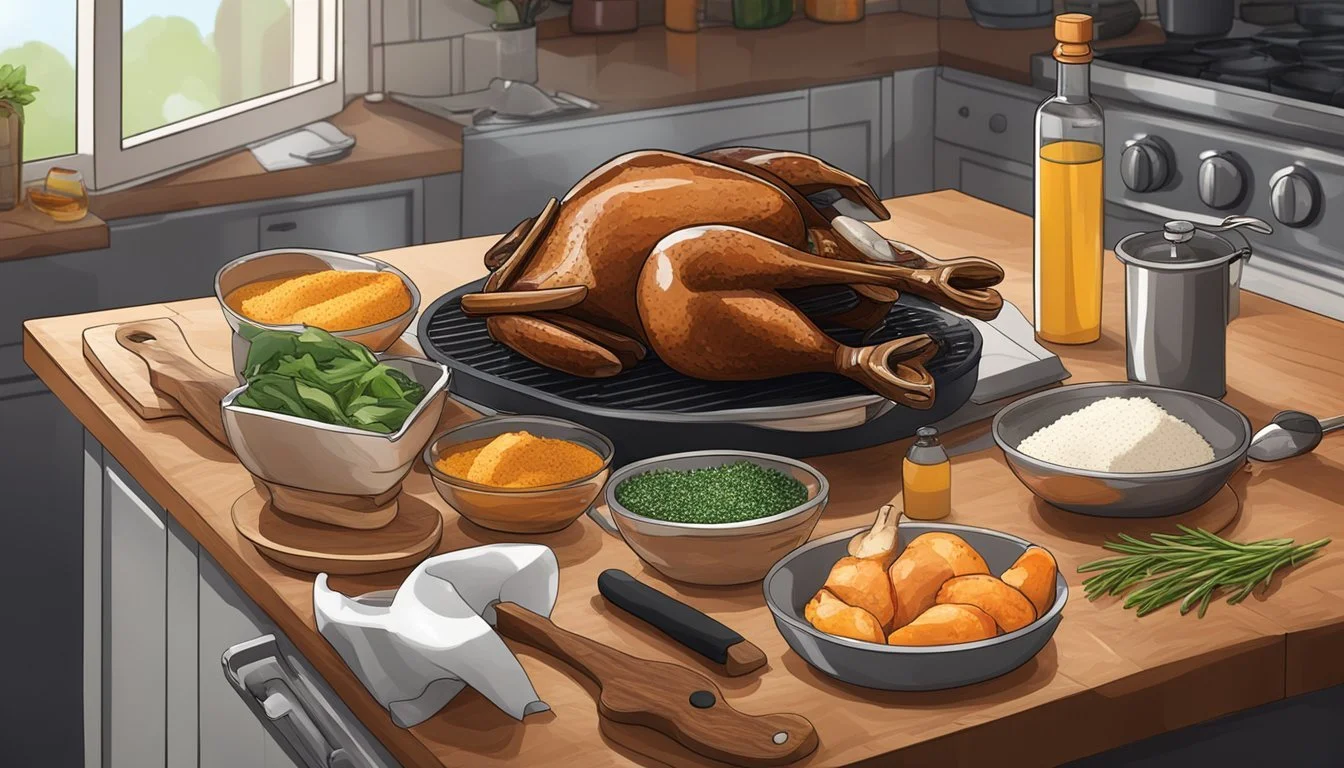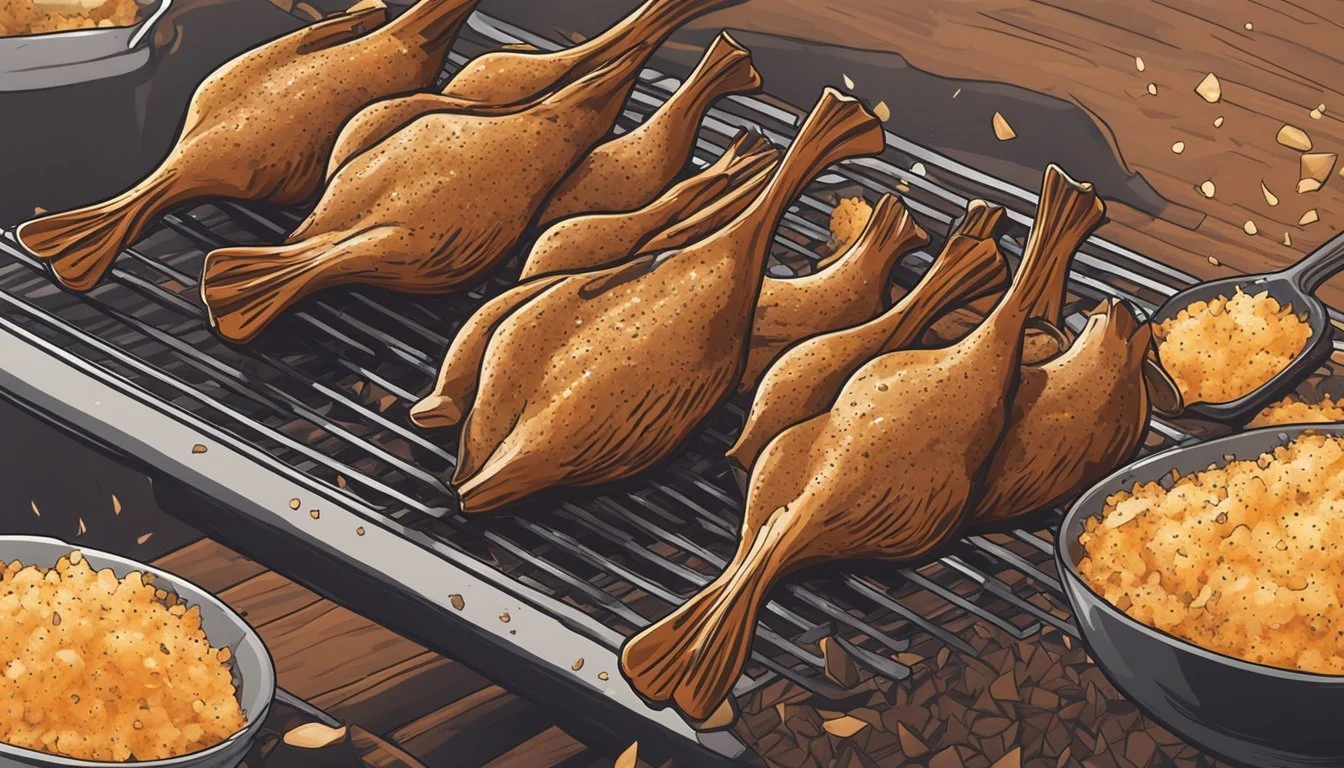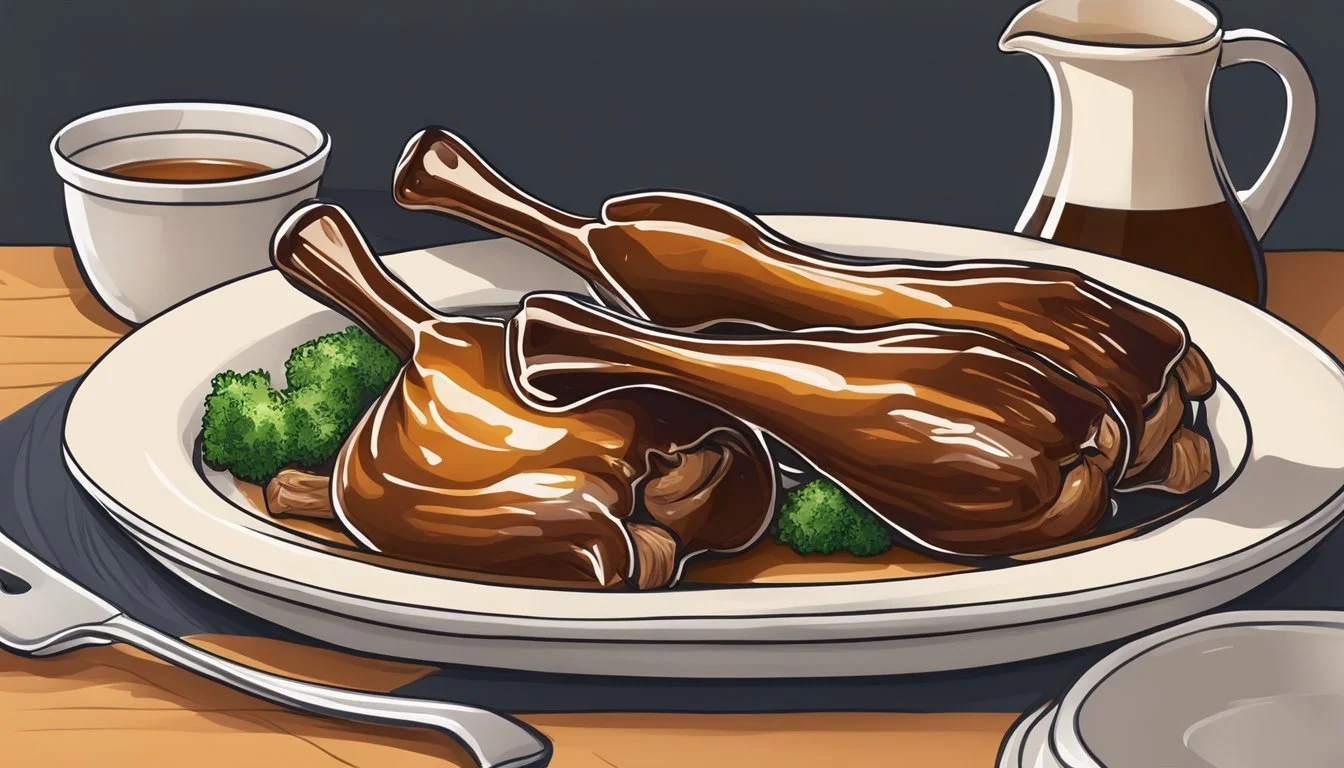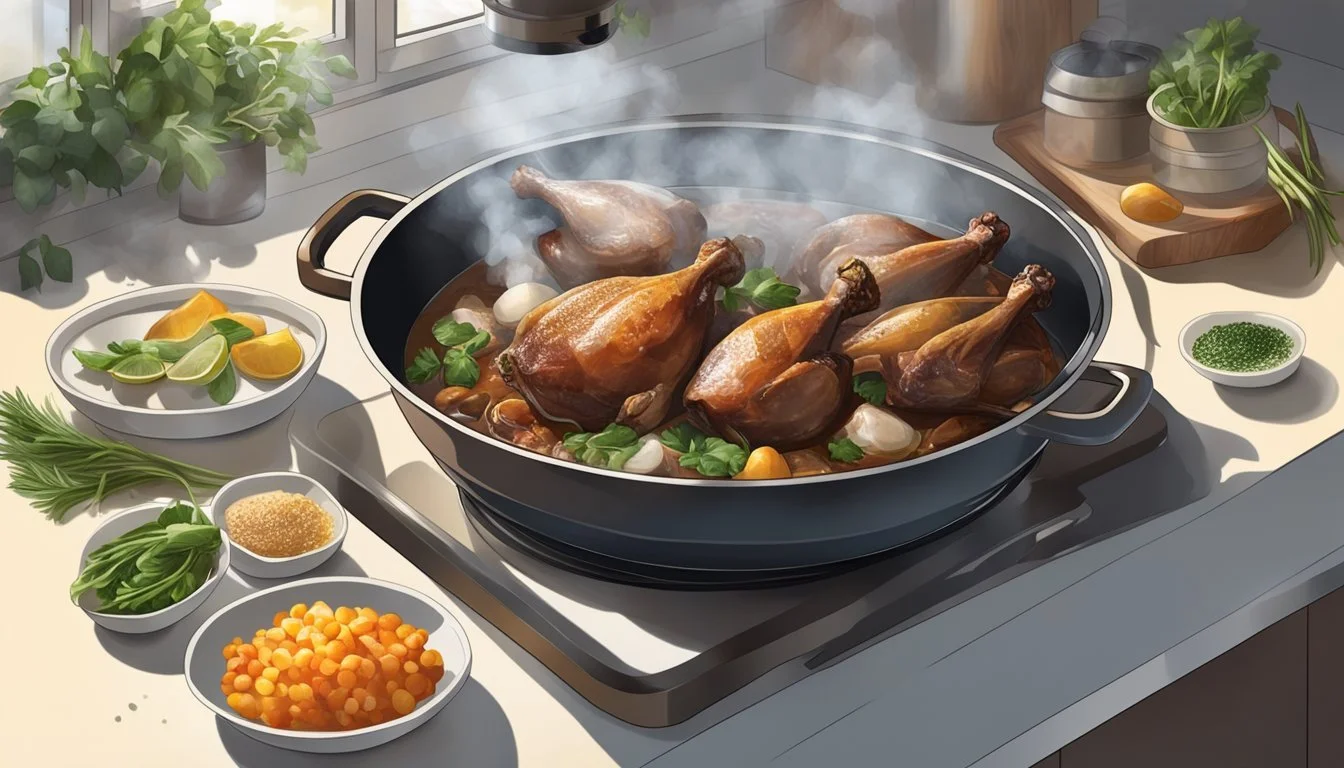Smoked Duck Legs at Home
Your Ultimate Guide to Perfect Flavor
Smoking duck legs at home elevates a simple poultry dish to a gourmet experience. The process transforms the rich, fatty meat into a tender, flavorful meal with a complex layer of smoky overtones. This culinary practice has been honed over generations and incorporates a blend of traditional techniques and modern twists to perfectly smoke the duck legs. Preparing duck in this way requires attention to detail, from the initial seasoning to the careful monitoring during the smoking process.
The preparation of smoked duck legs begins with a brine or rub, infusing the meat with flavors that will complement the natural duck taste. A dry rub often includes a variety of spices and herbs or a simple mixture of salt, pepper, and sugar. Some methods may involve refrigerating the seasoned duck legs overnight to allow the flavors to penetrate deeply. The smoking stage is critical, typically involving low temperatures that cook the meat slowly, rendering the fat and producing succulent results.
Home cooks wishing to attempt this technique will find that, with the right equipment and a bit of patience, creating smoked duck legs can be a rewarding endeavor. It's an opportunity to explore the interplay of flavor, temperature, and time, resulting in a dish that is sure to impress. The smoked duck legs can be enjoyed in a multitude of ways, whether served as a main dish, part of an appetizer spread, or as a unique addition to salads and pasta dishes.
Understanding the Basics of Smoking Meat
Smoking meat is an age-old culinary technique that enhances flavor, tenderness, and preservation. The right combination of heat, smoke, and time can turn simple ingredients into delectable dishes.
What Is Smoking?
Smoking is a method of cooking where meat is exposed to smoke from burning or smoldering materials, usually wood. This process not only imparts a unique smoky flavor but also tenderizes and preserves the meat. It typically occurs at temperatures between 225 and 275 degrees Fahrenheit and can last several hours, depending on the size and type of meat.
Different Types of Smokers
There are various types of smokers, ranging from traditional to modern:
Offset Smokers: Consist of a large chamber (where the meat is placed) and a smaller firebox. Heat and smoke flow from the firebox into the chamber.
Vertical Water Smokers: Feature a water pan between the heat source and the meat, creating a moist smoking environment.
Electric Smokers: Use electricity to heat wood chips that produce smoke, offering convenience and precise temperature control.
Pellet Smokers: Burn compressed wood pellets and are valued for their ease of use and consistent temperature.
Each type of smoker has its own advantages, and the choice often comes down to personal preference and the specific requirements of the meat being smoked.
Choosing the Right Wood for Flavor
The wood used in smoking is a key factor that influences the final flavor of the meat:
Mesquite: Offers a strong, earthy flavor best suited for red meat.
Hickory: Imparts a robust, bacon-like taste, making it versatile for many types of meat.
Apple: Yields a mild, sweet flavor, ideal for poultry and pork.
Pecan: Provides a rich, nutty taste without being overpowering.
Wood can come in the form of logs, chunks, chips, or pellets. Logs and chunks are better for longer smokes, while chips and pellets are more suitable for shorter cooking times. It’s important to match the wood type to the meat to ensure a complementary flavor profile.
Preparing the Duck Legs
Proper preparation of duck legs is essential for ensuring flavor, tenderness, and moisture retention. This involves selecting high-quality meat, careful trimming, brining, and the application of a flavorful rub which lay the foundation for delicious smoked duck legs.
Selecting Duck Legs
Choosing the right duck legs is the first critical step. For domestic ducks, Moulard legs are preferred for their larger size and flavorful fat content. Wild duck legs can also be used but are typically leaner, affecting the smoking process. One should aim for duck legs with a firm, plump appearance and skin that is free from blemishes.
Trimming and Cleaning
The preparation stage begins with trimming excess skin and fat that won't render out during the smoking process. It's imperative to pierce the skin gently using a sharp knife, making small incisions over the surface, without cutting into the meat itself. These incisions help in rendering the fat and contribute to crispier skin. The duck legs should be rinsed and patted dry.
Brining for Moisture Retention
Brining the duck legs can enhance moisture retention and flavor. A basic brine may consist of:
Water
Kosher salt
Sugar
Bay leaves
Black peppercorns
Combine the ingredients in a pot and simmer for a period, allowing the brine to cool completely before submerging the duck legs for several hours, typically overnight.
Applying the Dry Rub
After brining, the next step is to apply the dry rub, which often comprises:
Kosher salt
Freshly ground black pepper
Thyme
Dry Rub Composition
Ingredient Measurement Kosher salt 1 tbsp Ground black pepper 1 tsp Thyme, finely chopped 1 tsp
Coat the duck legs evenly on both sides with the rub, ensuring the seasonings adhere properly. This mix will not only season the duck legs but also help in forming a flavorful crust during the smoking process.
Smoking the Duck Legs
When smoking duck legs, precision in setup and process ensures a tender and juicy result. The right temperature and smoking technique are vital for the perfect smoked duck.
Setting Up the Smoker
To begin, one must ensure the smoker is clean and ready for use. The charcoal or wood of choice should be loaded into the smoker. Utilize fruit woods like cherry or apple to complement the duck's flavor. It's important to have a water pan filled to help maintain moisture during the cooking process.
Controlling Temperature and Smoke
Maintain a consistent temperature range of 225 to 250 degrees F within the smoker. The smoke should be thin and blue, indicating it's not too hot. This will gently infuse the duck legs with flavor without burning them.
The Smoking Process
Position the duck legs skin side up on the grill grate, ensuring they are spaced out for even smoking. Close the lid and allow the duck legs to smoke slowly. This slow cooking process is crucial for the fat to render, making the duck skin crisp and the meat tender.
Determining Doneness
After about three hours, check the internal temperature of the duck legs. They are done when the internal temperature reaches 165 degrees F, which is the safe minimum for poultry. Duck legs should feel tender to the touch, and the meat should easily pull away from the bone.
Finishing Touches
After the smoked duck legs have absorbed the rich flavors from the smoking process, applying the finishing touches can make all the difference. These steps ensure the meat is succulent and the skin is crispy, making it a memorable dinner for family and friends.
Resting and Serving
Once the smoked duck legs are taken off the smoker, it’s crucial to let them rest. This allows the juices to redistribute throughout the meat, ensuring each bite is flavorful and moist. The ideal resting time is typically 10 to 15 minutes before serving. To serve, one may simply arrange the smoked duck legs on a platter or slice the meat off the bones if preferred.
Optional Glazes and Sauces
Applying a glaze or serving with a sauce can elevate the taste of smoked duck legs. Honey balsamic glaze is a popular choice that complements the meat’s smokiness with a touch of sweetness and acidity:
Honey Balsamic Glaze:
Ingredients:
Honey: 4 tablespoons
Balsamic vinegar: 2 tablespoons
Salt: A pinch
Cayenne pepper: 1/4 teaspoon (optional for heat)
Preparation:
Combine all ingredients and mix well.
Brush the glaze on the duck legs during the last 30 minutes of smoking.
Alternatively, one can serve the duck with a variety of sauces on the side, allowing guests to personalize the flavor to their liking. Duck pairs well with fruity sauces, classic orange glaze, or even a rich barbecue sauce, depending on the desired flavor profile.
Recipes and Pairings
This section provides a culinary roadmap for those looking to master smoked duck legs at home. It showcases a variety of duck leg dishes, recommended side dishes, and ideal wine and beverage pairings for a comprehensive dining experience.
Duck Leg Dishes
Smoked duck legs can be prepared with a dry rub or marinated to infuse depth of flavor. A popular recipe involves seasoning duck legs with a mixture of poultry seasoning, which typically includes thyme, sage, marjoram, rosemary, black pepper, and nutmeg. Maple Leaf Farms suggests preparing a dry rub and allowing the seasoned duck legs to set in the refrigerator for at least 2 hours before smoking. For a gourmet twist, one might braise the smoked legs with rich ingredients like olives or serve them in a duck confit style, where the legs are slowly cooked in their own fat.
BBQ Smoked Duck Legs:
Dry rub with a blend of fennel, oregano, and paprika before smoking
Smoke for 3 hours for optimal tenderness
Duck Leg Confit:
Cure the legs overnight with salt and aromatics
Slowly cook in duck fat at a low temperature until melt-in-the-mouth tender
Side Dishes
When considering side dishes to accompany smoked duck legs, one should aim for choices that balance the rich, smoky flavors. A refreshing salad, particularly one with bitter greens, citrus, or a vinaigrette, can cut through the fattiness of the duck. Pasta tossed with a light sauce and aromatic herbs or a seasonal vegetable soup can also complement the dish well.
Salads:
Persimmon and orange salad with a sesame-ginger dressing
Mixed greens with a tangy balsamic vinaigrette
Pastas & Soups:
Fennel-infused pasta with a light olive oil sauce
Velvety butternut squash soup with notes of sage
Wine and Beverage Pairings
Choosing the right beverage to match the richness of smoked duck legs is crucial. A full-bodied red wine with good acidity and fruity notes, such as a Pinot Noir or Merlot, pairs well with the smokiness of the meat. For those who prefer white wine, a Chardonnay with hints of oak can stand up to the bold flavors. Non-alcoholic options, like a citrusy lemonade, offer a refreshing counterpoint to the smokey duck.
Wine:
Red: Pinot Noir with its cherry and earthy notes
White: Oak-influenced Chardonnay for its creamy texture
Non-Alcoholic:
Homemade lemonade sweetened with a touch of honey
Storing and Reusing Smoked Duck
Properly storing smoked duck ensures it retains its flavor and moisture when reheated. Whether refrigerating or freezing leftovers, the key is to maintain the meat's integrity for future enjoyment.
Refrigerating and Freezing
Refrigerating: Smoked duck should be placed in the refrigerator within two hours of cooking. To maximize freshness, one should wrap the duck legs tightly in aluminum foil or plastic wrap, or place them in an airtight container. Properly stored, smoked duck can last in the refrigerator for 3 to 4 days.
Wrap tightly to prevent drying out
Store up to 4 days
Freezing: For longer storage, freezing is an option. It's recommended to portion the duck legs before freezing. Wrap each leg in foil, followed by a layer of plastic wrap to combat freezer burn and preserve flavor. Smoked duck can be kept in the freezer for up to three months.
Double-wrap in foil and plastic
Freeze for up to 3 months
Reheating Tips
Oven: The best method for reheating smoked duck to maintain its moisture and fat is using the oven. Preheat the oven to 350 degrees Fahrenheit. Place the duck legs in a baking dish with a small amount of broth or water to keep them moist. Cover with foil and heat until the internal temperature reaches 165 degrees Fahrenheit.
Preheat oven to 350°F
Cover to retain moisture
Heat to 165°F internal temperature
Stovetop: One can also reheat duck legs in a skillet over medium heat. First, one should allow the duck legs to reach room temperature to ensure even warming. Add a small amount of duck fat or oil to the skillet to help restore some of the fatty richness and to prevent sticking.
Allow to reach room temperature
Reheat over medium heat
Add duck fat or oil for flavor
Using these methods, the smoked duck's proteins will remain tender, and its flavor will be preserved without losing the essential qualities that make it a succulent dish.
Tips and Tricks
The secrets to perfect smoked duck legs are all about managing the skin's texture and preserving the meat's natural juiciness. Here are specific strategies to ensure one achieves the desired results.
Achieving Crispy Skin
To get that coveted crispy skin on smoked duck legs, they must first ensure that the duck's skin is thoroughly dried before smoking. Patting it dry with paper towels can make a huge difference. Once the skin is dry, they should consider scoring the skin in a crosshatch pattern, being careful not to cut into the meat. This allows the fat underneath to render properly, which is crucial for a crispy, browned finish. One might want to start the smoking process at a lower temperature to render the fat slowly and then increase the heat at the end to crisp the skin.
Dry the skin thoroughly: Pat with paper towels.
Score the skin: Cut in a crosshatch pattern without reaching the meat.
Render the fat: Start at low heat to melt the fat slowly.
Maintaining Juiciness
For juicy and succulent meat, it's essential to keep a close eye on the internal temperature. Overcooking can dry out the meat, making it tough, so using a meat thermometer to ensure it reaches an ideal internal temperature of 165°F is vital. Another technique to maintain juiciness is to brine the duck legs prior to smoking. A brine solution typically includes ingredients like salt, sugar, and aromatics that help the meat retain moisture and add flavor.
Monitor internal temperature: Aim for 165°F with a meat thermometer.
Brine for moisture: Soak in a salt, sugar, and aromatic solution.
By following these tips and tricks, one can confidently smoke duck legs that boast a crispy skin on the outside and juicy, succulent meat on the inside.
Social Media and Community
As home smoking of duck legs gains popularity, enthusiasts are increasingly turning to social media to showcase their culinary achievements and connect with like-minded individuals. This connectivity is central to expanding one’s smoking repertoire and gaining new insights.
Sharing Your Results on Social Media
Home chefs often take to Instagram and Facebook to share images and stories of their perfectly smoked duck legs. Utilizing hashtags such as #smokethatduck can categorize content, making it easier for others to discover and appreciate the effort. Regular postings can stir a following or even start a #smokethatduck series on these platforms. A composition of tantalizing images shared on TikTok could also spiral into a series of viral culinary videos, inviting interactions and tips exchange.
Joining Smoking Communities
Active participation in smoking communities on various social media platforms can be highly beneficial. Individuals can join Facebook groups or follow forums dedicated to smoking meats, including duck. These communities serve as a hub for sharing recipes, techniques, and successes. The camaraderie in these groups encourages learning and provides a support system for smokers of all experience levels.
Frequently Asked Questions
What temperature should be used to smoke duck legs?
Most recipes suggest a low temperature of 225 degrees Fahrenheit to ensure that the fat renders properly without drying out the meat.
How long does it typically take to smoke duck legs?
The process normally takes about 2 to 3 hours, depending on the size of the duck legs and the exact smoking temperature.
Is there a recommended dry rub for smoked duck legs?
Yes, many prefer a blend of salt, pepper, sugar, and various herbs like thyme. The blend can be suited to personal taste.
Essential Rub Ingredients Purpose Salt Flavor base and moisture control Sugar Balances salt and aids browning Pepper Adds heat Thyme Herbal fragrance
Do I need to brine the duck legs before smoking?
Brining is not mandatory but is recommended as it helps to season the meat and keep it moist during the smoking process.
What's the best way to ensure the duck skin becomes crispy?
Scoring the skin and cooking skin side up helps the fat render and makes the skin crispier. Additionally, one might finish the duck legs on high heat for a few minutes if needed.
Conclusion
In the art of home cooking, smoking duck legs can be considered both a culinary challenge and a rewarding endeavor. One takes pride in achieving the rich, savory flavors characteristic of this dish. With attentive preparation and patience, it results in a meal that promises to delight the palate with its complex taste profile.
The process requires effort, from brining or seasoning to the careful monitoring of the smoker's temperature. The end product is worth the endeavor: the legs emerge flavorful, where the balance of fatty richness and the hint of saltiness create a harmony of taste.
There is also room for creativity with smoked duck legs. One can experiment with a variety of herbs, spices, and brines to personalize the dish. This flexibility allows the cook to adapt to personal preferences and dietary needs, making this dish as versatile as it is delightful.
For those concerned about health, one can rest assured that duck is a source of essential nutrients. While it is certainly rich, it provides a different nutritional profile compared to other meats.
Remember that the key to perfectly smoked duck legs is incremental observation and temperature control. They should always be prepared to accommodate enough time for the meat to fully absorb the smoky flavors and reach the correct internal temperature.
In mastering this dish, one not only adds a luxurious item to their culinary repertoire but also gains the satisfaction of enhancing their cooking skills. The journey from preparation to the first bite reflects a passion for quality home cooking.





